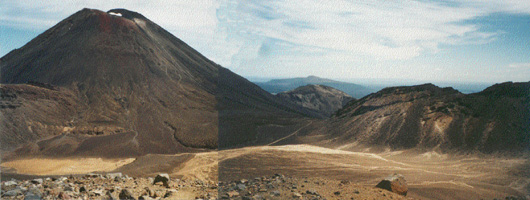

 Waitangi and Bay of Islands
Waitangi and Bay of Islands
Auckland
Waitomo Caves
Rotorua
Tongariro
Wellington

 The Bay of the Islands is at the North East side of the North Island and includes the settlement of Waitangi on its shores.
This is where the Treaty of Waitangi was signed in 1840, under this treaty the Maori people swore allegiance to the Queen
in return for Britain's protection.
The Bay of the Islands is at the North East side of the North Island and includes the settlement of Waitangi on its shores.
This is where the Treaty of Waitangi was signed in 1840, under this treaty the Maori people swore allegiance to the Queen
in return for Britain's protection.
There is also a Waitangi and Bay of Islands page
which has more photographs and information about this area.

 Auckland, the capital city of New Zealand, has been host of the America's cup yatching race. Outside the National
Maritime Museum there is a full size America's Cup yatch which is parked on the street rather than in the water!
The museum cafe overlooks the harbour (which is where I took this photo) and was a nice place for lunch.
Auckland, the capital city of New Zealand, has been host of the America's cup yatching race. Outside the National
Maritime Museum there is a full size America's Cup yatch which is parked on the street rather than in the water!
The museum cafe overlooks the harbour (which is where I took this photo) and was a nice place for lunch.

 This picture is of the Aranui Cave in Waitomo which is much less visited than the famous glow worm caves.
It is, however, more spectacular with its formations of stalegtites and stalegmites.
This picture is of the Aranui Cave in Waitomo which is much less visited than the famous glow worm caves.
It is, however, more spectacular with its formations of stalegtites and stalegmites.
The glow worm cave was discovered in 1857 and first opened to tourists in 1888.
Each glow worm emits a small pin prick of light to attract food.
The guided tour of the caves includes a boat ride through the glow worm grotto where thousands of glow worms light up the ceiling of the caves.
The Waitomo Caves website is at www.waitomocaves.co.nz

 Rotorua, in the centre of the North Island, is a renowned geothermal area and is one of New Zealand's top tourist attractions.
There are geysers, coloured pools, bubbling mud, hot springs and even a geothermal valley where even the streams steam.
Rotorua was a staging post for Victorian tourists coming to visit the famous pink and white terraces of Lake Rotomahana.
A volcanic eruption of Tarawera in 1886 completely destroyed these wonders.
Today you can also visit the village buried by the eruption and cruise over where the terraces used to be.
There is a lot see in this area and there is a separate Rotorua wepage and includes more information and photos.
Rotorua, in the centre of the North Island, is a renowned geothermal area and is one of New Zealand's top tourist attractions.
There are geysers, coloured pools, bubbling mud, hot springs and even a geothermal valley where even the streams steam.
Rotorua was a staging post for Victorian tourists coming to visit the famous pink and white terraces of Lake Rotomahana.
A volcanic eruption of Tarawera in 1886 completely destroyed these wonders.
Today you can also visit the village buried by the eruption and cruise over where the terraces used to be.
There is a lot see in this area and there is a separate Rotorua wepage and includes more information and photos.


The Tongariro Crossing is the most famous one day walk in New Zealand. It passes two active volcanoes, crosses lava fields, passes hot springs, craters and emerald lakes.
The walk takes 8 hours and, being one way, you need to arrange transport back.
There is a bus that goes from the visitors centre in the park in the morning and returns there from the end of the walk in the evening.
However, the last bus out is 8.45am so you need to be organised!



 Wellington, at the south end of the North Island, is New Zealand's second largest city.
The Museum of New Zealand, Te Papa, is excellent and has many interactive displays and there is lots to see and do there.
The Botanical Gardens give a great view over the city and can be reached by cable car (tram) which takes you to Kelburn.
There are two Observatories in the gardens, both near the tram stop, the 1941 Carter Observatory and the original Thomas King Observatory which was built in 1912.
Wellington, at the south end of the North Island, is New Zealand's second largest city.
The Museum of New Zealand, Te Papa, is excellent and has many interactive displays and there is lots to see and do there.
The Botanical Gardens give a great view over the city and can be reached by cable car (tram) which takes you to Kelburn.
There are two Observatories in the gardens, both near the tram stop, the 1941 Carter Observatory and the original Thomas King Observatory which was built in 1912.

The highlight of the Botanical Gardens (and the most visited spot) is the Lady Norwood Rose garden (above), which boasts over 300 different types of roses.

Return to Top / NZ Map / NZ South Island / Rotorua / Waitangi
Travel Pages : /Australia
/ Costa Rica
/ Costa Rica Wildlife
/ Italy
/ Namibia
/ New York





